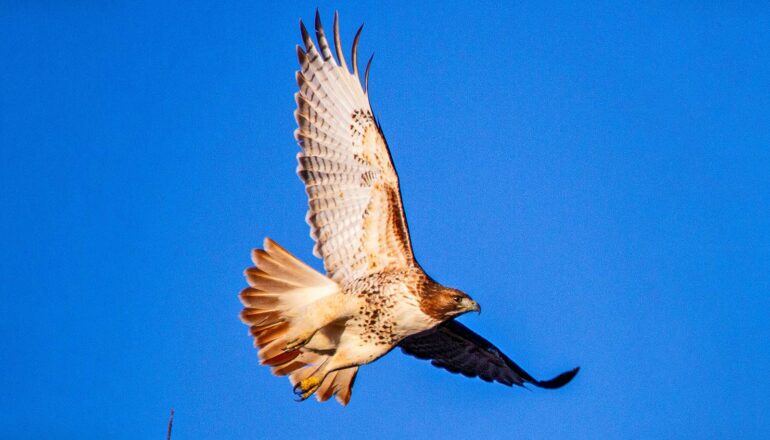
Researchers report for the first time that soaring birds use their lungs to enhance their flying in a way that has evolved over time.
Soaring birds—like osprey, eagles, falcons, even vultures—can stay aloft in the air seemingly forever, rarely flapping their wings. They glide along rising air currents in a way that has fascinated humans and scientists for centuries.
The new study in Nature finds, in short, that unlike the lungs of mammals, bird lungs do more than just breathe. An air-filled sac within the birds’ lungs is believed to increase the force the birds use to power flight muscles while soaring.
“It has long been known that breathing is functionally linked to locomotion, and it has been demonstrated that flapping enhances ventilation,” says Emma Schachner, an assistant professor at the University of Florida’s College of Veterinary Medicine.
“But our findings demonstrate that the opposite is also true in some species. We have shown that a component of the respiratory system is influencing and modifying the performance of the flight apparatus in soaring birds, who are using their lungs to modify the biomechanics of their flight muscles.”
Mammalian lungs are flexible and tidally ventilated—that is, air flows in and out along the same path.
In contrast, birds have a unique way of breathing: They have a stationary lung that gets air pumped through it in one constant direction by a series of balloon-like air pockets that expand and deflate. Branching off from these air pockets are many small, extensions called diverticula, which vary by number and size across avian species and whose functions remain poorly understood.
Schachner discovered the unique air sac, known as a subpectoral diverticulum, or SPD, by accident as she worked on another project relating to the anatomy of red-tailed hawks. Looking at CT scans, she noticed a huge bulge that sits in between the pectoralis—the downstroke flapping muscle—and the supracoracoideus muscle, or upstroke flapping muscle. Both muscles are located on the front of the bird’s chest.
The observation led Schachner to hypothesize that this air sac might be important for the mechanics of soaring. To test her hypothesis, she worked with two key collaborators, including Andrew Moore, an evolutionary biologist at Stony Brook University.
The researchers surveyed the presence or absence of the air sac in 68 bird species that broadly represent living avian diversity to assess whether soaring flight and the unique structure are evolutionarily correlated.
The dataset predominantly consisted of a collection of micro CT scans of live birds provided by Scott Echols, an avian surgery specialist from Utah, who had obtained the images for unrelated clinical purposes.
Their analyses were unequivocal: The SPD has evolved in soaring lineages at least seven different times, and is absent in all nonsoaring birds.
“This evolutionary pattern strongly suggests that this unique structure is functionally significant for soaring flight,” Schachner says.
To better understand the air sac’s impact on the mechanics of flight, Schachner worked with Karl Bates of the University of Liverpool in the United Kingdom, to digitally model its effect on the pectoralis muscle, focusing on red-tailed and Swainson’s hawks.
“Measuring the behavior of the SPD in a real hawk as it soars in the sky is close to impossible, so instead we built a computer model of the SPD, bones, and wing muscles to gain the first insights into how they might interact,” Bates says. “This computer model also allowed us to change hawk anatomy, specifically to remove the SPD—again, something we can’t do in a real bird—to further understand its impact on flight.”
The computer models suggest that inflation of the air sac increases the lever arm of the pectoralis muscle, much like using a screwdriver to open a paint can provides better leverage than using a coin.
In addition, the team found that the anatomy of the pectoralis muscle of soaring birds is significantly different from that of non-soaring birds in ways that improve force generation. Taken together, these results provide strong evidence that the SPD optimizes the function of the pectoralis muscle in soaring birds by improving their ability to keep the wing in a static, horizontal position.
“Part of what makes this such an important discovery is that it reshapes how we think about the interaction between locomotion and respiration,” Schachner says. “From previous studies, we know that locomotion, like running or wing flapping, enhances lung ventilation. But now we’ve shown the inverse: The lung is also able to fundamentally modify the way that locomotion works in soaring birds.”
Schachner and her team ruled out other possibilities for the function of the SPD. By looking at CT scans of a live, sedated red-tailed hawk while she breathed, they demonstrated that the birds can voluntarily collapse the air sac and still breathe, and can also independently open and close it.
“The evolutionary story here couldn’t be clearer,” Moore says. “Our data indicate that the SPD only evolves in birds that soar, and did so at least seven times independently across distantly related soaring lineages. So, whether you’re looking at a Western gull, a turkey vulture, a sooty shearwater, a bald eagle, or a brown pelican, they’ve all got an SPD that improves their ability to soar.”
The research also suggests that birds’ lungs may have many other unknown and interesting nonrespiratory functions that we have yet to find, Schachner says.
“Birds are wildly diverse. Think about how different an ostrich is from a hummingbird or a penguin,” she says. “It is likely that their lungs are involved in an array of really fascinating functional and behavioral activities that are waiting to be discovered.”
The Louisiana State University Research Enhancement Program and the University of Florida Gatorade Award Allocation funded the work.
Source: University of Florida
The post Soaring birds use lungs to enhance their flying appeared first on Futurity.
from Futurity https://ift.tt/OUPmpKX
No comments:
Post a Comment